#South Central Railway
Text
Train fact: NAMED TRAINS!
So you've probably heard of the Flying Scotsman. Big green thing, turned 100 this year, probably the most famous locomotive in the UK, if not the world. Adapted into Thomas the Tank Engine with a whole lot of charisma and eyebrows. But did you know that name wasn't hers originally?
'The Flying Scotsman' is actually the name (formerly a nickname) of the train. The locomotive is Flying Scotsman's monster named for it. She was given the name in 1924, to help promote said service at the British Empire exhibition. Any engine, with any rack of coaches, or any train set, can be the Flying Scotsman.
Right now, it's run by LNER's new Azumas, which get a special little outfit about it:
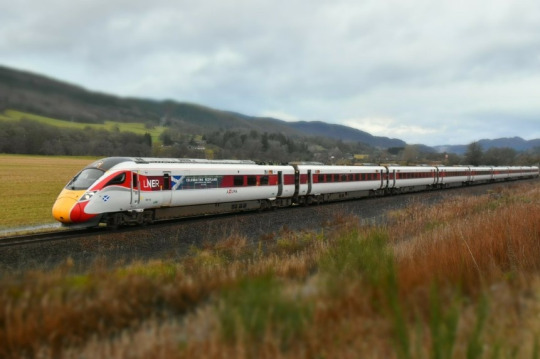
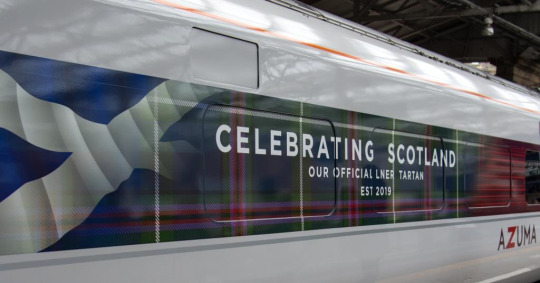
Most of the named trains in the UK were phased out with steam (although you can still catch the Sheffield continental from Sheffield to St. Pancras, or the Northern Lights from King's Cross to Aberdeen, among a handfull of others) but they live on elsewhere.
Some are luxury touring trains, like Japan's Seven Stars in Kyushu (left) or South Africa's Blue Train (right).


Transport isn't really the goal here. They sell out months in advance and cost anywhere from hundreds to thousands of dollars, depending on the class of ticket you get. They're an Experience, and a very cushy experience at that. Just look at their interiors!

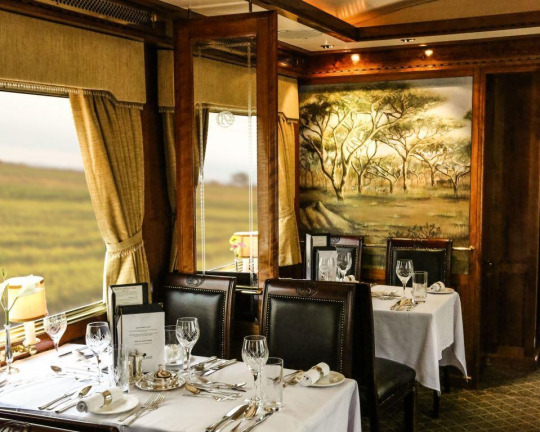
(yes, that's a piano)
But the vast majority of named trains in operation (as far as I can tell) are regularly-running exepress services across Asia.
Japan names their Shinkanens, India, Pakistan, Bengladesh & Sri Lanka often name their intercity expresses. These are practical, long-distance services, often named for monuments, like India's Ajanta Express, named for the Ajanta caves:
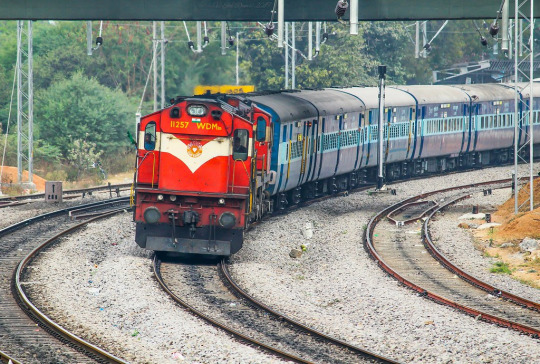
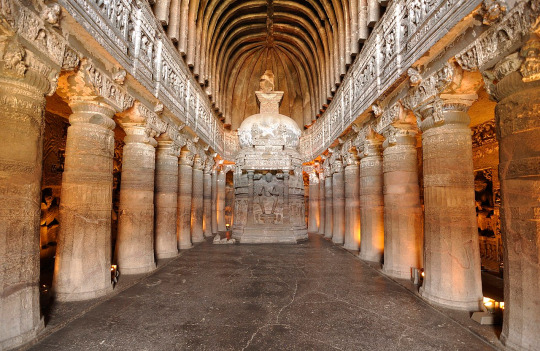
Or their operating regions, like Sri Lanka's උත්තර දේවී | Princess/Queen of the North:

Some North American countries also kept historic named routes, like Amtrak's Sunset Limited, or Canada's Ocean, which has operated continuously since 1904:

but my personal favorite named services are Australia's historically-nicknamed "The Fish", named after one of its drivers:

and the numerous trains that have been companion-nicknamed "The Chips" to match.
#Train facts!#ids in alt text#Sri Lanka Railways#LNER#modern LNER! Modern LNER! I know!#South Central Railway#Indian railways#NSW Train Link#via rail canada#the blue train#seven stars in kyushu#LNER Azuma
168 notes
·
View notes
Text
Trainposting :3


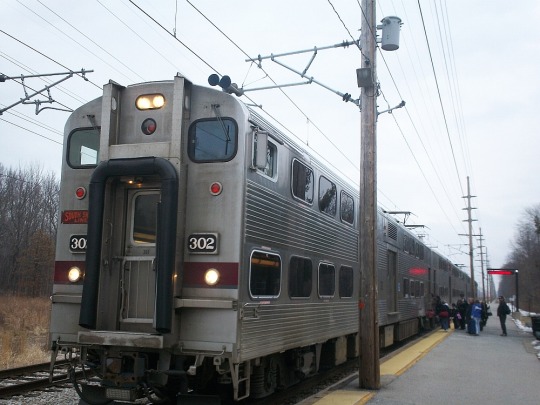
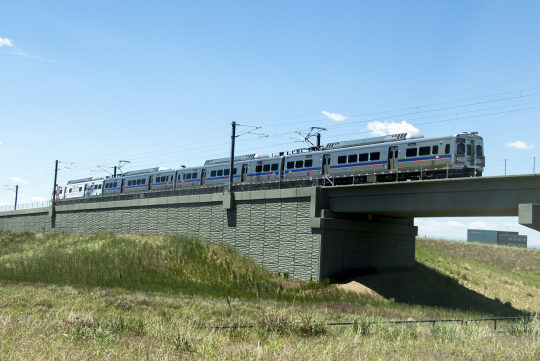
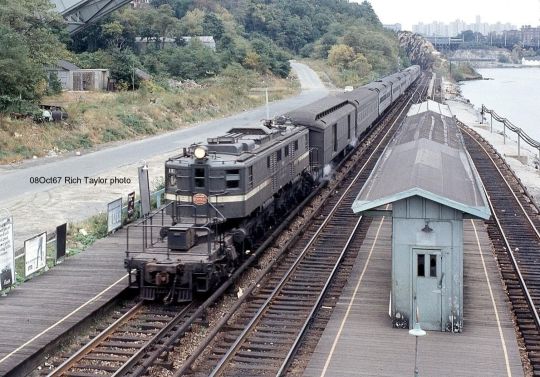
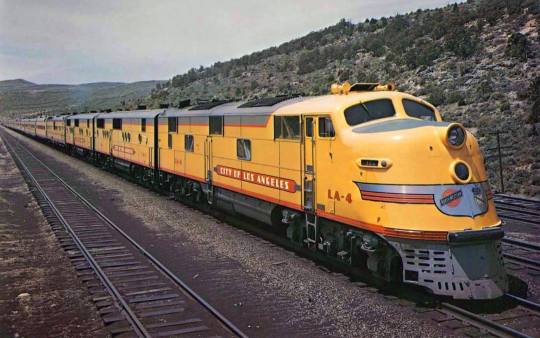




#trainposting#amtrak#electric traction#reading railroad#amtrak cascades#southern railway#southern serves the south#northern pacific#rock Island Railroad#new york central#south shore railroad#union pacific#steam locomotive#passenger train#electrification#electric train
76 notes
·
View notes
Text
861 Act Apprentice Position in South East Central Railway
Unlock a world of opportunity with South East Central Railway’s Act Apprentice positions! Ideal for candidates with ITI, 10th, or 12th qualifications, these coveted roles offer a gateway to a rewarding career in the railway sector. Nestled in the heart of Bilaspur, Chhattisgarh, South East Central Railway beckons aspiring apprentices to embark on a journey of learning and growth.
Eligibility…

View On WordPress
#employment news#Fresher Jobs#Fresher Jobs in Govt Organizations#Fresher Recruitment in Govt Organizations#Fresher Vacancy#Fresher Vacancy in Govt Organizations#government jobs#government jobs in india#government vacancy#govt jobs#govt vacancy#Jobs in South East Central Railway#Railway Jobs#railway recruitment#railway recruitment in india#Railway Vacancy#Recruitment in South East Central Railway#sarkari naukri in india#south east central railway employment#south east central railway jobs#south east central railway recruitment#south east central railway vacancy#Vacancy in South East Central Railway
0 notes
Text

"SECR Recruitment 2024: 861 Apprentice Posts - Apply Now"
The South East Central Railway (SECR) has announced 861 Apprentice vacancies. To apply, candidates need a minimum qualification of 10th grade and ITI certification. The job location is Nagpur, Maharashtra, with a monthly pay scale of Rs. 7,700 to Rs. 8,050. Applications are open from April 10th to May 9th, 2024.
#South East Central Railway#SECR Recruitment#SECR Railway#South East Central Railway Zone#SECR apprentice
0 notes
Note
What does the "banana republic is a fucked up name for a store" post you reblogged mean? I'm afraid of looking dumb.
The term "banana republic" was originally coined to describe countries in Central and South America (mainly Honduras and Guatemala) whose economies were rendered dependent on the production and export of bananas (among other agricultural goods, but mainly bananas) by American fruit corporations leveraging the power of the U.S. government, the U.S. military and the CIA.
Throughout most of the of the 20th century, American corporations such as United Fruit, Cuyamel, and the Standard Fruit Company owned large portions of these countries' lands, to the point that in some cases they controlled their railway, road, and port infrastructure, and they engaged in a variety of imperialist actions to lower production costs, such as violence against labor activists and anti wage reform lobbying.
The pinnacle of this phenomenon was the 1954 Guatemalan coup, when United Fruit convinced the goverment of US president Dwight D. Eisenhower that the elected president of Guatemala, Jacobo Árbenz (who had expropriated some of the company's unused land and given it to Guatemalan peasants) was secretly working with the Soviet Union, resulting in a CIA coup which deposed the Árbenz government and replaced it with a thirty-year right-wing military dictatorship which effectively acted as a puppet government to protect the interests of United Fruit and the U.S. government.
Nowadays the term has broadened to refer to any small, economically unstable country with an economy which has been rendered dependent on the export of a particular natural resource due to economic exploitation by a more powerful country.
7K notes
·
View notes
Text
South Central Railway ALP Recruitment 2023 For GDCA Assistant Loco Pilot Out
South Central Railway SCR ALP & Tech Recruitment 2023 For GDCA Assistant Loco Pilot Released at Official Website of @scr.indianrailways.gov.in
Latest update on 28 July 2023,
South Central Railway ALP Recruitment 2023 Notification
GDCA Assistant Loco Pilot South Central Railway’s (SCR) Railway Recruitment Cell has announced a recruitment notice for a total of 1014 Assistant Loco Pilot (ALP),…

View On WordPress
#Latest Job#Loco Pilot Job#New Job#Railway Job#RRB Job#SCR ALP Job#South Central Railway ALP Recruitment 2023
0 notes
Text
South East Central Railway Recruitment 2023 Apply Online 1016 Assistant Loco Pilot, Technician, Engineer Vacancies
South East Central Railway Recruitment 2023 Notification of GDCE 01/2023: South East Central Railway (SECR), Railway Recruitment Board, Bilaspur invites online applications from regular and eligible employees (except RPF / RPSF) of SECR for filling up following Assistant Loco Pilot, Technician and Junior Engineer posts against General Departmental Competitive Examination (GDCE) Quota. The SECR…
View On WordPress
#1016#2023#apply#assistant#central#east#engineer#loco#online#pilot#railway#Recruitment#south#technician#uncategorized#Vacancies
0 notes
Text
Delhi hotels near railway station
The Ashok is a luxurious 5-star hotel in Chanakyapuri, Delhi, which is in close proximity to the airport. It is an iconic property that showcases authentic Indian hospitality with a perfect blend of modern amenities and traditional architecture. The hotel is known for its world-class infrastructure and offers a wide range of accommodation options, including spacious rooms and suites that are elegantly designed and furnished with all the necessary amenities for a comfortable stay in Delhi.
For more info-
Visit us: https://itdc.co.in/hotels/the-ashok/
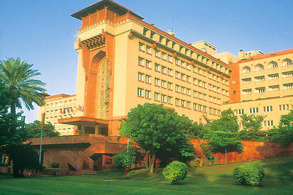
Apart from the luxurious accommodation, The Ashok offers an exceptional dining experience with its multiple restaurants serving a variety of cuisines. The hotel also features state-of-the-art conference and banquet facilities, bank with ATM, fitness centre, shopping arcade making it a popular choice for business travelers. In addition, the hotel has a beautiful outdoor pool. The Ashok is a perfect destination for travelers seeking a luxurious and comfortable stay in Delhi.

#Delhi hotels near railway station#Conference Halls in Delhi#hotels in south Delhi#Hotels in Central Delhi#Best 5 Star Hotels in Delhi#hotels in delhi near Connaught Place#hotels near new delhi railway station
0 notes
Text
ज़रूरी सूचना, 2 दिन पटरी पर नहीं दौड़ेगी 3 ट्रेनें, रद्द की गई
बिलासपुर। दक्षिण पूर्व मध्य रेलवे के बिलासपुर मंडल ने कटनी लाइन में चलने वाली तीन ट्रेनों को रद्द कर दिया है. 4 और 11 जून को इन ट्रेनों को रद्द किया जा रहा है. जिन ट्रेनों को रद्द किया गया है वह गरीबों की ट्रेन कही जाती है. इसमें छोटे छोटे स्टेशनों के मुसाफिर यात्रा कर अपने रोजगार के साथ ही अन्य जरूरी काम करते हैं.
4 और 11 जून को शहडोल बधवाबारा, लोरहा चंदिया रोड स्टेशन के बीच समपार फाटक को…
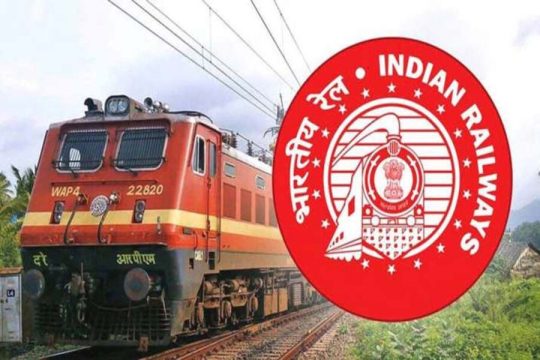
View On WordPress
#bilaspur#BILASPUR BIG NEWS#BILASPUR DIVISION#BILASPUR NEWS#BILASPUR RAIL DIVISION#Breaking Hindi News#indian railways#Latest News in Hindi#SOUTH EAST CENTRAL RAILWAY#Train cancelled list#videos#दक्षिण पूर्व मध्य रेलवे#बिलासपुर#बिलासपुर न्यूज़#बिलासपुर बिग न्यूज़#बिलासपुर मंडल#बिलासपुर रेल मंडल
0 notes
Text
Indian Rail: शालीमार, गोंदिया एक्सप्रेस ट्रेन हुई कैंसिल, इस ट्रेनें को किया डायवर्ट
Indian Rail: शालीमार, गोंदिया एक्सप्रेस ट्रेन हुई कैंसिल, इस ट्रेनें को किया डायवर्ट
South East Central Railway : भारतीय रेलवे (Indian Railways) के दक्षिण पूर्व मध्य रेलवे (South East Central Railway) अंतर्गत नागपुर डिविजन के वर्धा-चितोड़ा स्टेशनों (Wardha-Chitoda Railway stations) के बीच वर्धा यार्ड का आधुनिकीकरण (Modernization of Wardha Yard) और नॉन इंटरलॉकिंग (Non Interlocking) का काम किया जा रहा है.
ये ट्रेन हुई रद्द इस कार्य के चलते रेलवे ने छत्रपति शिवाजी…
View On WordPress
#indian railways#Shalimar Gondia Express#South East Central Railway#Wardha-Chitoda Railway stations#दक्षिण पूर्व मध्य रेलवे#भारतीय रेलवे#वर्धा-चिटोडा रेलवे स्टेशन#शालीमार गोंदिया एक्सप्रेस
0 notes
Text
ট্রেনের যাত্রীদের জন্য বড় খবর! টিকিট বুক করার নিয়মে IRCTC-র বড়সড় পরিবর্তন
ট্রেনের যাত্রীদের জন্য বড় খবর! টিকিট বুক করার নিয়মে IRCTC-র বড়সড় পরিবর্তন
ভেরিফাইতে ক্লিক করার পরে মোবাইলে ওটিপি যাবে, এটি দিয়েই মোবাইল নম্বর ভেরিফাই করা সম্ভব ৷ এরপরেই অ্যাকাউন্ট থেকে যেকোনও ট্রেনের টিকিট বুক করা যাবে ৷ প্রতীকী ছবি ৷
Source link
View On WordPress
#Eastern Railways#Indian Railways#Indian Railways has initiated the form of new ticket booking policy.Latest Business News#Indian Railways Ticket Booking System#IRCTC#IRCTC Booking#IRCTC Ticket Booking#Latest Business News#Northern Railways: ট্রেনের টিকিট বুক করার ক্ষেত্রে বড়সড় পরিবর্তন আইআরসিটিসির ৷ IRCTC has been changed the rules of ticket booking#South Central Railways#South Eastern Railways#Ticket Booking
0 notes
Text
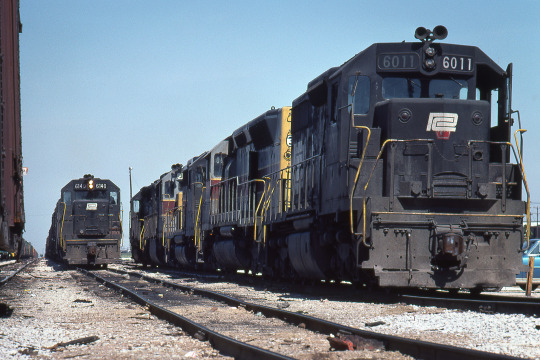
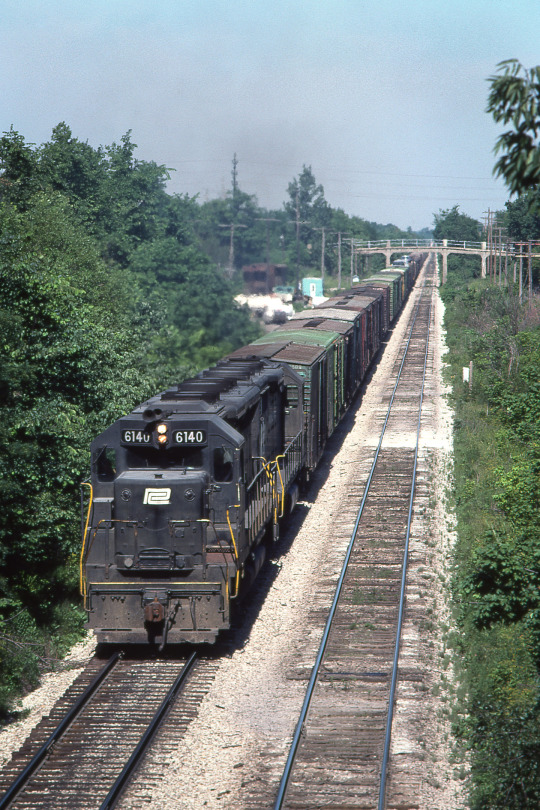
Westbound from Avon
The first image here shows a westbound train ready to depart Avon Yard (in the distance, on the left hand side of the frame). We're on the former Big Four/NYC west of Indianapolis.
Conrail is two months old when these pictures were taken so the power standing off to the side is interesting—three units of the Erie Lackawanna along with a Penn Central unit with a Pennsy logo peeking out. Two of three EL units (SD45-2 and SDP45) were purchased with the idea of having larger fuel capacity for long runs from the east to Chicago without refueling.
The second image has the train down the line about six miles, directly south of Danville, Indiana. We're looking down on the railway from State Road 39.
Two images by Richard Koenig; taken June 5, 1976.
#railroadhistory#railwayhistory#penncentral#conrail#erielackawanna#sdp45#sd45-2#danvilleindiana#avonindiana#avonyard#bigfour#newyorkcentral
65 notes
·
View notes
Text
465 Apprentice Recruitment - South East Central Railway
465 Apprentice Recruitment – South East Central Railway
South Western Railway
No:-P/BSP/Act Apprentice/Notification/2022-23
Engagement of Act Apprentices in South East Central Railway, Bilaspur Division for the year 2022-23 under Apprentices Act 1961 and Apprenticeship Rules1 962.
Online application through the website: https://www.apprenticeshipindia.gov.in till 22.06.2022 (till 23:59 hrs) are invited from the eligible candidates for engagement as…
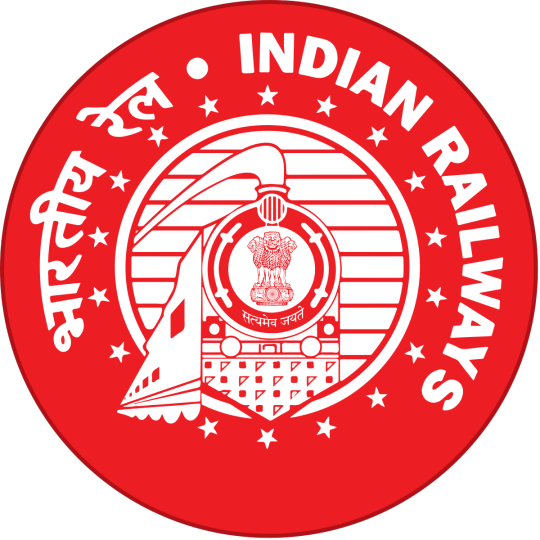
View On WordPress
#act apprentice jobs#act apprentice recruitment#act apprentice vacancy#act apprentices jobs#act apprentices vacancy#apprentice recruitment#apprentice vacancy#apprentices vacancy#Jobs in South East Central Railway#Recruitment in South East Central Railway#south east central railway employment#south east central railway jobs#south east central railway recruitment#south east central railway vacancy#trade apprentice jobs#trade apprentice recruitment#trade apprentice vacancy#Vacancy in South East Central Railway
0 notes
Text

SECR 2024 Recruitment: 733 Apprentices Posts - Apply Now
South East Central Railway has recently announced 733 vacancies for Apprentices. Eligibility criteria include completing 10+2 and holding an ITI certification. The job location is in Bilaspur, Chhattisgarh. The pay scale is as per norms. Applications began on March 12, 2024, and will close on April 12, 2024. No payment is required for applying. Don't miss this opportunity! Apply now.
0 notes
Text
The shapes of railway networks
A while ago @ariadsishereagain asked me about countries that have no railway networks, and what I think of them. That's a fascinating question that has been in my mind ever since, because the truth is you can tell a lot about a country and in particular it's history during the 19th and early 20th century by its railway network. So let's do that. And the best way to do that is by looking at the incredibly detailed open-source world railway map OpenRailwayMap, a part of the OpenStreetMap project. I really recommend it! And let's start with one of my favorite examples of how railway networks differ:

At this zoom level the site sadly only shows incomprehensible internal abbreviations rather than city names, so let me explain: What we have here are France and Germany, along with some of the UK and Italy, some of various neighbouring countries and all of Switzerland, Belgium and Luxembourg.
France and Germany are the ones that I find the most interesting, because the shapes of their networks are so different. Not only is the german one much more dense, but you can see completely different patterns.
In France, the job of railroads is to bring people to Paris (PLY, short for Paris Gare de Lyon) The lines stretch out into every part of the country, but almost all of them converge onto mainlines going into Paris. You can see some lines along the coasts and the borders, and there is a medium distances circle around Paris (passing MZ, DN, TO, short for Metz, Dijon, Tours). This whole pattern is known as the Legrande Star, after Baptiste Alexis Victor Legrande, the french government official who designed it. His goal was to provide great access to Paris, the nation's undisputed political, cultural and economical centre. A couple of decades later, Charles de Freycinet added plans to connect all departments to the railway network, but he still followed the idea that the ultimate goal of almost every rail line was Paris. And so it was, and largely remained. Even the high speed lines, in red, follow this pattern to this day.
A result is that you will have to go to Paris whether you want to or not. Lille-Strasbourg? You're going through Paris. Bordeaux-Dijon?

You're going through Paris, and get to make your own way from Gare Montparnasse to Gare de Lyon on the Metro (and it isn't even a direct metro, you have to change trains). It's a massive detour but it's not like you have a choice.
Even if there is a direct TGV or a connection outside the main stations of Paris, you're still ending up very much near Paris; the difference is just that you're not going via the city centre, but rather via Disneyland. Legrande wanted to bring people to Paris; he was less concerned about connecting other places with each other.
Now compare Germany, and you will see a network that is more dense, but most importantly, utterly chaotic. You can see hints of a France-like star around Berlin (BSPD, short for Berlin Spandau, which isn't the most important station but what can you do), but it's really only dominating its immediate surroundings, the region of Brandenburg. You can see vague hints of a similar star around Hamburg (AH; don't ask) or Munich (MH), but also a massive tangle around the Rhine-Ruhr industrial area (around KD), or around the Frankfurt am Main area (FF). Red high speed lines are essentially random. Some of them do go to Berlin, sure. But many, like the one from Cologne to Frankfurt (KD to FF) or the one from Hanover (HH) south, do not.
And that really reflects the history. Germany wasn't a unified country when railroad construction began, and even though it did unify shortly thereafter, there's no hiding that its different parts developed separately, with no central planning, ever since the middle ages. Germany doesn't have a single central city like France. Berlin is the biggest and most important city, but not by far. Hamburg has huge cultural and industrial influence, Frankfurt is the most important financial centre and airport, Munich is huge, and there are agglomerations like the Rhine-Ruhr region that used to beat all of them in terms of industry. And the rail network, with no single central focus point, reflects that.
That doesn't mean Germany doesn't have its own blind spots. Due to being split in two, the east-west links aren't great. Getting e.g. from Cologne (near KD) to Dresden (DH) is pretty painful. Ironically, Berlin is one of the places that really suffers from this. There are plenty of trains to it from Cologne but they take forever, and you can see why: A lot of the route isn't high speed, it's just more or less upgraded normal lines. If you have a single destination, then it's easy to build all the lines there. If you want high-speed connections between everything, that's more difficult. (Also, our government isn't investing anywhere near enough into the rail network, both compared internationally and on its own terms, but that's a different issue)
Other countries in Europe tend to be somewhere between the extremes. Spain is fairly centralised around Madrid.
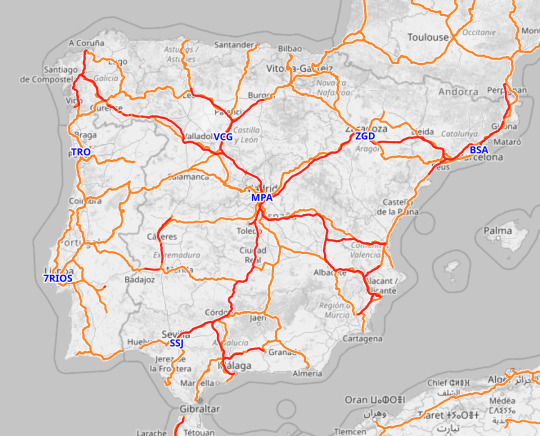
The UK is just as focused on London as France is on Paris, but it has strong regional networks around Leeds and Sheffield, and the weirdness in Scotland (four different lines between Glasgow and Edinburgh and counting!).
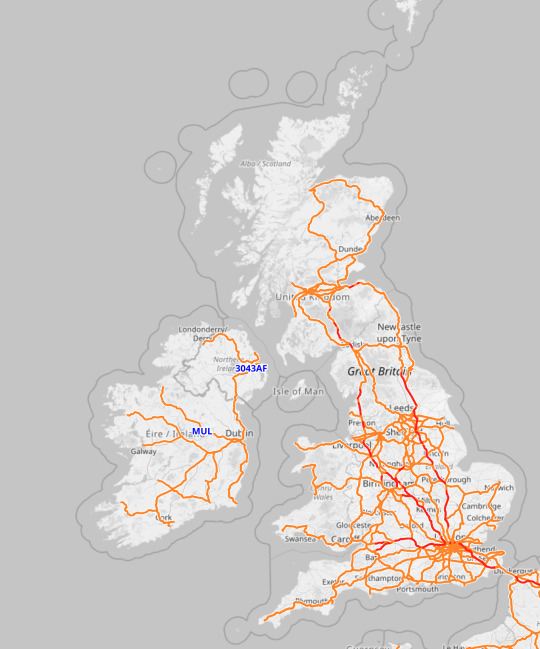
Italy, especially south of the Po valley, almost looks like a ladder: Lines are either on the one side of the Apennines or the other, with a few brave ones crossing through.
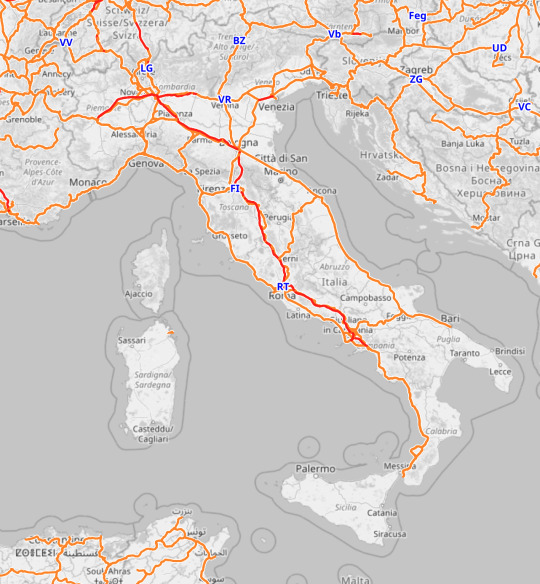
This works overseas as well. Describing the continental US as "like Germany" is certainly going to raise some eyebrows, but the map doesn't lie:
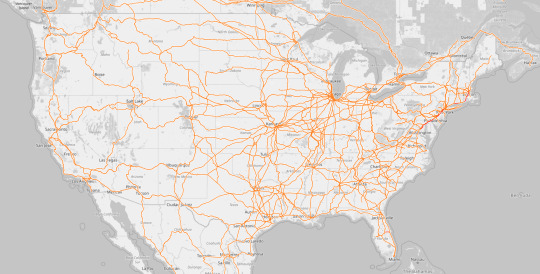
It's all on a completely different scale, but it's also a federal country with no one single clear centre. Yes, New York and Los Angeles are big and important, but neither is an all-powerful centre of the nation. What's fun about the US is that it's almost gradient-like: The more west you go, the fewer the railroads get. You can also nicely see the Alleghenies by the shadow they cast: Just a few brave rail lines managed to make their way through or around. Other characteristic items are the huge tangle that is Chicago, the closest thing the US has to a railroad capital; and the many places where lines are almost duplicated (just count how many different ways you can get from Chicago to Memphis, or Chicago to Cleveland), thanks to different competing railway companies that all hated (and sometimes still hate) each other's guts.
So that's what's mostly considered the "western world" or "industrialised world". I skipped Japan, China and India because the post is going to get too long no matter what, but they're all fascinating as well.
But if we go away from there look at countries where the colonialism was less settlers and more exploit mostly from afar, we see another very odd pattern emerge, like here in sub-saharan Africa:

The selection is somewhat arbitrary because you can find the same pattern everywhere south of the Sahara, and in one case (Mauretania) even in the Sahara: A railroad that goes straight to the coast. (The isolated sections inland are due to issues with the map software, they're all connected to one of the lines to the coast)
This kind of railroad is designed to extract a country's resources, and not much else. In Mauretania (not in this picture), that's iron ore. Elsewhere it might have been other ores, precious metals, gemstones, but also very often agricultural products, spices, dyes. The railway line exists to take these things, and bring them to a port. The line is not designed to actually help the nation grow economically. Think about it: All things being equal, you're probably just as likely to want to go parallel to the coast as perpendicular to it.
Also, each of these lines were built because there's something interesting at the end of it, or at least someone suspected there might be. If you wanted to develop the area, it would make sense to trade the interesting stuff in Togo with the interesting stuff in Benin. But the railway lines are not set up for that at all. The goal is to get the interesting stuff to a ship, and occasionally soldiers to the place where the interesting stuff comes from.
These days, the area that I screenshotted here is actually massive, full of people. The city of Abidjan has more than four million inhabitants (more than Berlin), Lomé has 1.7 million, Cotonou and Porto-Novo come close to a million if taken together, and nobody's quite sure about Lagos, but it's at least 14 million, and the metropolitan region might be 24 million. This is a band of cities that researchers think might, in the next few decodes, become on par with Washington-Philadelphia-New York-Boston in the US, or the Tokyo-Osaka in Japan.
And the rail connections in this region do not reflect this at all. A high speed passenger line and/or a heavy duty freight line could allow all these places to do business with each other, allow people to move to or visit each other, and just spur a lot of economic development. But the powers that built the lines, the colonial powers, were not interested. They had their harbour, and the region behind it, and they just wanted to extract whatever was there.
To be clear, that does not mean the railroads are evil now. Selling natural resources is still better than bringing no money into the country. And there are a lot of places where railroad junctions and depots became the point where cities were founded, so in some countries these lines do end up connecting the most important cities, more or less by accident. It's just that other lines or more lines are sorely missing.
A simple example for how this could look like is provided by Australia, where the colonists were settlers and did want to develop the land economically:

You have the lines from the coast inland, and sometimes quite a lot of them. But you can also see a line along the east coast, connecting the cities, and you can see that someone said "we need to build a railroad across the entire continent. No, two actually". That is not to say that Australia does everything right with railroads, they have a lot of weirdness there. But you can see that the railroads had more jobs than to just move resources to ships.
(The big exception is the Pilbara region, in the north west, with its odd tangle of lines. Those are all just resource extraction lines, where the world's heaviest freight trains haul iron ore from various mines to various ports. The mines and ports are owned by different mining companies that don't like each other, so everybody has their own line from their own harbour to their own mine, even if a different line would have been shorter. That's why you get the tangle there.)
So, that's basically it. The railroad map of a country shows you a lot about how a country works, and more specifically how it worked during the late 19th and early 20th century, when most railroads were built. Where they lead to and where they don't reflects what planners thought of as important, and in turn, it has shaped the way these countries developed. And personally, I always find this endlessly fascinating.
#railroads#maps#i suppose you could take the 6 to bercy and walk from there but it's still not exactly convenient
299 notes
·
View notes
Text



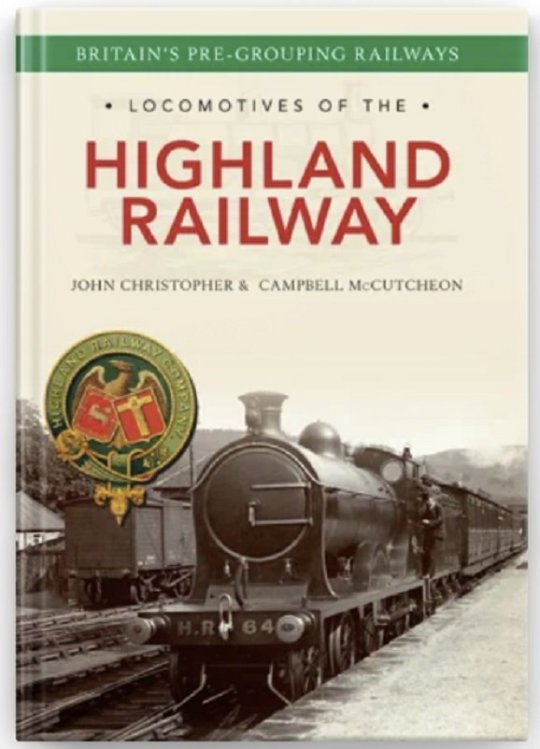

On February 1st 1865 the Highland Railway was formed from the amalgamation of Inverness and Perth Junction and the Inverness and Aberdeen Junction Railways.
Back in the day every region had it’s own local railway company covering the different areas around the country. The Highland Railway ran from Perth in Central Scotland north to Inverness and then on up the east coast to Wick and Thurso. From Dingwall, the railway ran west to Kyle of Lochalsh to serve Skye and the Western Isles. From Inverness, another line ran east to Keith, where it connected with the line to Aberdeen. Several branches were built from this core network to serve nearby towns.
This is a longer post than I normally put together but hope you get an idea of how all these wee companies ran, and ended up becoming the one company, before of course the bigger companies ate them all up. Some of the stations are now gone, but others mentioned, like Kingussie, Nairn, Keith and Dunkeld survive to this day, and I often pass through them on my travels north. It also gives us an insight intothe infamous Beeching cuts in the 60’s which butchered the rail network, if Beeching had his way there would be no railways beyond Inverness!!
Inverness was always the centre of the Highland Railway. It was the company’s headquarters and principle station. All trains led to Inverness.
The original proposals to construct railways to Inverness were made in the mid-1840s. Rival routes were proposed from Perth and Aberdeen . The Perth & Inverness Railway was considered too hilly for the locomotives of the day, but the Great North of Scotland Railway (GNSR) from Aberdeen was authorised. The GNSR struggled to raise capital in the post-railway mania period and eventually started construction as far as Huntly in 1852, opening that line in 1854.
The people of Inverness then stepped in and started building their own line from the Inverness end, initially as far as Nairn, the Inverness & Nairn Railway (I&N) was opened on 6th. November 1855 but by then plans were being made to extend this railway to meet the GNSR. After some discussion, the Inverness & Aberdeen Junction Railway (I&AJ) was promoted to build the line from Nairn to Keith where it met the GNSR extension from Huntly. The I&AJ was completed on 18th. August 1858,when it took over the working of the I&N.
The people of Inverness were never satisfied with the long journey round via Aberdeen , especially as the GNSR’s station was half a mile from that of the line from the south and connections were not always maintained. Thus was born the Inverness and Perth Junction Railway (I&PJR) which ran from Forres via Grantown, Kingussie and Drumochter summit to Dunkeld where it met with end on with the Perth and Dunkeld Railway which had opened in 1856. The I&P was authorised in 1861 and opened just two years later, being worked from the outset by the I&AJR. The two companies amalgamated on 1st. February 1865 to form the Highland Railway.
Meanwhile construction northwards from Inverness had already started, with a line to Dingwall (1862), Invergordon (1863), Bonar Bridge (1864), Golspie (1868), Helmsdale (1871) and Wick and Thurso (1874). Westward from Dingwall, the Dingwall & Skye Railway was opened to Strome Ferry in 1870.
In the 1890s, two additions were made to the main network. The direct line from Aviemore over Slochd to Inverness was completed in 1898, a year after the Skye line was extended to the present terminus at Kyle of Lochalsh. Several branches were opened from these main lines over the next 40 years, taking the final length of the system to some 242 route miles.Tourist traffic has always been a major source of income for the railways in the Highlands . The Highland Railway developed its own hotels at Inverness , Dornoch and Strathpeffer. It offered combined tours in conjunction with the steamer services of David MacBrayne. Each August it had to contend with the annual migration north for the ‘glorious twelfth.’
The railway played a major part in the First World War, when the Grand Fleet was stationed at Scapa Flow in the Orkney Islands . Worn down, like many other railways in the country, it became part of the London , Midland and Scottish Railway in 1923. The LMS continued to develop the lines, introducing dining cars and speeding up services. The Second World War again imposed a considerable strain on the lines.
On the nationalisation of the railways, the Scottish Region of British Railways took over. Soon the development of road transport made a significant impact on the use of the railway. The closure of branch lines, which had started in the 1930s, continued. The Beeching Plan of 1963 envisaged the closure of all lines north of Inverness , but this was not approved because those lines still provided a lifeline in winter. The old route from Aviemore to Forres and a number of intermediate stations on the main lines, were closed. Otherwise the main system remained intact, as it does today. Currently operated by ScotRail, the lines continue to provide a vital link to locals and bring many tourists to the area.
The Highland Railway was well known for its locomotives. Working the steep gradients of the main line, in particular, was always a challenge. Add strong winds and snow and the problems became even worse. The railway introduced the first 4-6-0s to the British Isles, commemorated in the preserved No.103 at the Glasgow Transport Museum . In the 1930s, the LMS Black 5s, locally always called “Hikers”, immediately proved their worth. The isolated nature of the country led British Railways to implement complete dieselisation early in the modernisation plan.
Today class 158 and 170 diesel multiple units work most of the trains, but you can still retire to bed in a sleeper on the line out of London Euston and wake up to the sound of a Class 67 struggling up Drumochter.
39 notes
·
View notes